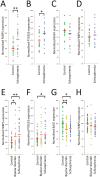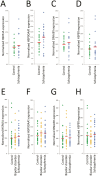Dysregulation of glucocorticoid receptor co-factors FKBP5, BAG1 and PTGES3 in prefrontal cortex in psychotic illness
- PMID: 24345775
- PMCID: PMC3866598
- DOI: 10.1038/srep03539
Dysregulation of glucocorticoid receptor co-factors FKBP5, BAG1 and PTGES3 in prefrontal cortex in psychotic illness
Abstract
Molecular abnormalities within the glucocorticoid receptor (GR) stress signaling pathway may confer, or reflect, susceptibility to stress in schizophrenia and bipolar disorder, but the extent of such abnormalities in the brain is not known. Using RNA-Seq and qPCR in two postmortem cohorts totaling 55 schizophrenia, 34 bipolar disorder and 55 control individuals, we identified increased FKBP5 and PTGES3 mRNA expression, and decreased BAG1 mRNA expression, in the prefrontal cortex in schizophrenia cases relative to controls (68.0% [p < 0.001], 26.0% [p < 0.01] and 12.1% [p < 0.05] respectively). We also observed increased FKBP5 and decreased BAG1 mRNA expression in bipolar disorder (47.5% [p < 0.05] and 14.9% [p < 0.005]). There were no diagnostic differences in steady-state FKBP51 protein levels, nor in HSPA1A, HSP90AA1, DNAJB1 or HSPB1 mRNA levels. GR, co-factor and chaperone mRNA levels were strongly correlated. These results reveal coordinated cortical dysregulation of FKBP5, PTGES3, BAG1 and GR genes within the glucocorticoid signaling pathway in psychotic illness.
Figures





Similar articles
-
Altered mRNA Levels of Glucocorticoid Receptor, Mineralocorticoid Receptor, and Co-Chaperones (FKBP5 and PTGES3) in the Middle Frontal Gyrus of Autism Spectrum Disorder Subjects.Mol Neurobiol. 2016 May;53(4):2090-9. doi: 10.1007/s12035-015-9178-2. Epub 2015 Apr 26. Mol Neurobiol. 2016. PMID: 25912394
-
Abnormal glucocorticoid receptor mRNA and protein isoform expression in the prefrontal cortex in psychiatric illness.Neuropsychopharmacology. 2011 Dec;36(13):2698-709. doi: 10.1038/npp.2011.160. Epub 2011 Aug 31. Neuropsychopharmacology. 2011. PMID: 21881570 Free PMC article.
-
Glucocorticoid receptor mRNA and protein isoform alterations in the orbitofrontal cortex in schizophrenia and bipolar disorder.BMC Psychiatry. 2012 Jul 20;12:84. doi: 10.1186/1471-244X-12-84. BMC Psychiatry. 2012. PMID: 22812453 Free PMC article.
-
The role of FKBP5, a co-chaperone of the glucocorticoid receptor in the pathogenesis and therapy of affective and anxiety disorders.Psychoneuroendocrinology. 2009 Dec;34 Suppl 1:S186-95. doi: 10.1016/j.psyneuen.2009.05.021. Psychoneuroendocrinology. 2009. PMID: 19560279 Review.
-
The FKBP51 Glucocorticoid Receptor Co-Chaperone: Regulation, Function, and Implications in Health and Disease.Int J Mol Sci. 2017 Dec 5;18(12):2614. doi: 10.3390/ijms18122614. Int J Mol Sci. 2017. PMID: 29206196 Free PMC article. Review.
Cited by
-
Does single gene expression omnibus data mining analysis apply for only tumors and not mental illness? A preliminary study on bipolar disorder based on bioinformatics methodology.Medicine (Baltimore). 2020 Aug 28;99(35):e21989. doi: 10.1097/MD.0000000000021989. Medicine (Baltimore). 2020. PMID: 32871949 Free PMC article.
-
Diurnal Alterations in Gene Expression Across Striatal Subregions in Psychosis.Biol Psychiatry. 2023 Jan 15;93(2):137-148. doi: 10.1016/j.biopsych.2022.08.013. Epub 2022 Aug 24. Biol Psychiatry. 2023. PMID: 36302706 Free PMC article.
-
FKBP5 genotype interacts with early life trauma to predict heavy drinking in college students.Am J Med Genet B Neuropsychiatr Genet. 2016 Sep;171(6):879-87. doi: 10.1002/ajmg.b.32460. Epub 2016 May 19. Am J Med Genet B Neuropsychiatr Genet. 2016. PMID: 27196697 Free PMC article.
-
Increased macrophages and changed brain endothelial cell gene expression in the frontal cortex of people with schizophrenia displaying inflammation.Mol Psychiatry. 2020 Apr;25(4):761-775. doi: 10.1038/s41380-018-0235-x. Epub 2018 Sep 13. Mol Psychiatry. 2020. PMID: 30214039 Free PMC article.
-
The Neurotransmission Basis of Post-Traumatic Stress Disorders by the Fear Conditioning Paradigm.Int J Mol Sci. 2023 Nov 15;24(22):16327. doi: 10.3390/ijms242216327. Int J Mol Sci. 2023. PMID: 38003517 Free PMC article. Review.
References
-
- Walker E. F. & Diforio D. Schizophrenia: A Neural Diathesis-Stress Model. Psychol Rev 104, 667–685 (1997). - PubMed
-
- Khashan A. S. et al. Higher risk of offspring schizophrenia following antenatal maternal exposure to severe adverse life events. Arch Gen Psychiatry 65, 146–152 (2008). - PubMed
-
- Agid O. et al. Environment and vulnerability to major psychiatric illness: A case control study of early parental loss in major depression, bipolar disorder and schizophrenia. Mol Psychiatry 4, 163–172 (1999). - PubMed
-
- Yung A. R. et al. Mapping the onset of psychosis: The Comprehensive Assessment of At-Risk Mental States. Aust NZ J Psychiatry 39, 964–971 (2005). - PubMed
Publication types
MeSH terms
Substances
Grants and funding
LinkOut - more resources
Full Text Sources
Other Literature Sources
Medical
Research Materials
Miscellaneous

